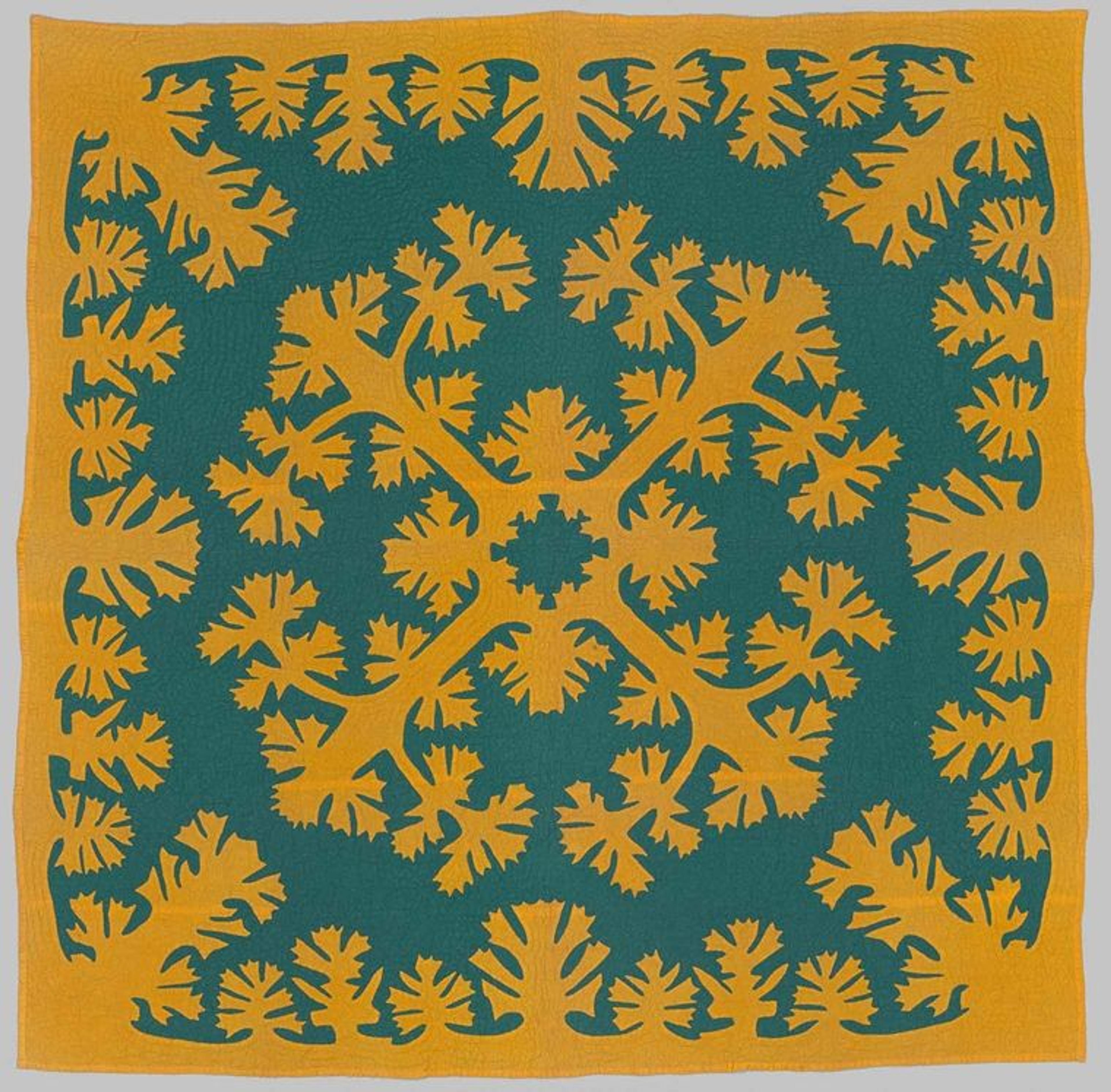The Yellow of the Mamo’s Wing: Lei Mamo, a #MetKids Poem

Hawaiian Quilt, Lei Mamo Pattern, ca. 1930. Made in Hawaii, United States. Cotton, 74 x 74 in. (22.2 x 188 x 188 cm). The Metropolitan Museum of Art, New York, Purchase, David Scott Parker Gift, 2017 (2017.183)
Hello! My name is Laurel Nakanishi. I am a poet from Hawai'i. When I first saw this kapa kuiki—this Hawaiian quilt—I was struck by its bold yellow color and the way the pattern seems dance across the turquoise background. Then I noticed the name of the quilt pattern: Lei Mamo. Kumu Sissy Serrao, a quilting teacher and expert on kapa kuiki, described the mamo design as having two meanings: the mamo could be a yellow 'ohi'a flower, which was highly regarded in Hawaiian traditions and culture. This design could also represent the mamo bird, whose bright yellow feathers were used to make feather capes and lei for the Ali'i, the High Chiefs and Chiefesses of Hawai'i.
Looking again at the quilt, I noticed that the pattern mimicked the feathery blossoms of the 'ōhi'a lehua tree. I have seen 'ōhi'a often in my hikes through the high mountains on the island of O'ahu, but I have never seen a mamo bird. Although the birds thrived on the islands for centuries, settlers in the nineteenth century cut down the forests—the mamo's home—to create ranches and plantations. They brought new diseases that sickened birds. By 1900, the species went extinct. There are no mamo birds left in the world.
There are so many mysteries in this quilt, like the extinct mamo and the label that reads: "Artist Unknown." Who was the person or people who designed and sewed this quilt? The poem I wrote imagines the artist, this quiltmaker as she (or "he" or "they") walks through the forest and spots one of the last mamo birds flitting through the trees.
Lei Mamo
Imagine first the glint of silver – a needle
diving and leaping across the turquoise
of this quilt, graceful as a dolphin trailing
silky threads. Can you see it?
And now the hand that holds the needle –
the hands that snip the cloth into feathery blooms.
Patient hands making tiny stitches all in a row.
Wise hands holding the knowledge of generations.
Can you see her, this quiltmaker? She is walking now
through a misty forest deep in the mountains
of Hawai'i. 'Ohi'a bloom like small flames,
kukui leaves shimmer overhead, and just there –
the long, plaintive whistle of a mamo bird.
Look up, his feathers are midnight black
with bursts of yellow at the wing and tail.
She watches the bird hop from branch
to bud, drinking from the purple trumpets
of the 'ōhā wai flower. All too soon, this bird
will be forgotten, along with the quiltmaker's name.
All that remains to us is the teal of this quilt –
so deep we could swim in it, and the yellow
of the mamo's wing.
Words to Discover
Extinct: when a species dies away
Mimic: to imitate or pretend to be something else
Regarded: esteemed; highly respected
Harvest: the process of gathering a crop or material
Kapa kuiki: a Hawaiian quilt
Kumu: teacher
'Ohi'a: a red or yellow blossoming tree
Mamo: a black and yellow bird native to Hawai'i
Lei: a necklace-like garland made of flowers or feathers
'Ōhā wai: a plant with purple flowers native to Hawai'i
Kukui: a kind of tree with silvery green leaves
Writing Prompt
Click here to find other pieces of art labeled "Artist Unknown." Take a moment to look carefully at the artwork, then try to imagine who created it. What did they look like? Where did they live? What might have inspired them to create this piece of art? Write a poem using your imagination.

Laurel Nakanishi
Laurel Nakanishi was raised in Kapālama, on the island of Oʻahu, Hawaiʻi. She is the author of the award-winning poetry book, Ashore and the chapbook, Mānoa|Makai. She has been fortunate to receive grants from the Fulbright Foundation, the Japan-US Friendship Commission/ National Endowment for the Arts, the US embassy in Nicaragua, and the Greta Wrolstad Foundation.
Laurel has taught poetry writing to children in Hawaiʻi, Nicaragua, Montana, and Miami. In 2012, she founded a community arts organization in Nicaragua, NicaArts, which she continues to direct. Focusing on the intersections between teaching, writing, and community organizing, Laurel collaborates with non-profits and schools in her home state of Hawaiʻi to bring creative writing opportunities to underserved children and young adults.